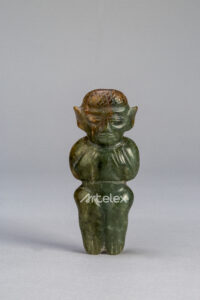Square Grid Patterns on the Head: Symbolic Markings in Hongshan Culture Artifacts
In many Hongshan culture artifacts, square grid patterns (斜格子) are engraved not randomly but with deliberate placement. Among these patterns, one particularly consistent location is the head—especially in full-body anthropomorphic statues and animal-shaped deities.
This consistent positioning suggests that the pattern was not merely decorative, but likely symbolic, representing concepts tied to sacredness, identity, or transformation.
Scholars have proposed that square grid motifs may represent portals, cosmic pathways, or thresholds of consciousness—particularly when placed on the head, a part often associated with intellect, spirit, or divine connection in many ancient cultures.
In the context of shamanic or spiritual iconography, these head-markings may reflect a point of spiritual communication, suggesting that the figures served as mediators between the earthly and the divine.
The repeated presence of these patterns in Hongshan iconography highlights a structured symbolic language—one that likely played a role in the formation of religious and cosmological systems in early East Asian civilization.

